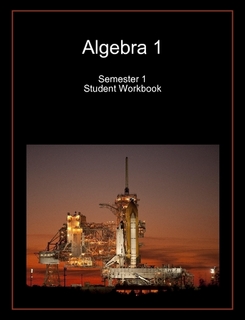|
|
Algebra 1

|
|
|
Description
This course will cover the topics normally covered in a first year high school algebra course. This course is normally taken by students in grade eight or nine. Students should have completed a course in Pre-algebra or its equivalent before enrolling in Algebra 1. A detailed course outline is shown below.
|
Lecture and Class Time
Class time will primarily be spent on instruction. Students should bring their Student Workbook to each class, or a printout of the pages for that week. The pages of the workbook are identical to the instructor's lecture notes, except the student version has the solutions and answers deleted. During the lecture the students take notes and solve the example problems in the workbook.
Videos of the lectures are also available online, and these videos go through the same lecture notes, point by point. Students use the videos to cover any material that time constraints did not permit us to cover in our weekly class. Or, if a student misses a class or needs to review the material, all of the course content is available online. It is possible to take the entire course online via distance learning, and many students have done so.
|
Textbook
The textbook is no longer required for this class. All of the course content
comes from the lectures and the Student Workbook. This course was originally based on
Algebra, Structure and Method, Book 1 by Dolciani, Brown, Sorgenfrey, and Cole,
published by McDougal Littell, 2000 edition. The topics covered in this course will
correspond closely to the topics covered in this book, although the explanations in the
lectures are expanded over those in the book, at times significantly.
If needed, a copy of the textbook can be provided as a reference and as a source of
additional practice problems.
|
Homework, Tests and Grades
Students will be given specific assignments to complete each week. Assignments will consist of Practice Problems from the workbook, instructional videos online, and written assignments.
In this class there is a distinction between Practice Problems and Homework Problems. Practice Problems are found in the workbook, and students check their answers with the solutions provided. Homework assignments and tests are printed from the website, completed, and turned in for a grade.
To maximize instructional time in class, tests will be given at home. One final exam for each semester will be taken in class at the end of each semester. Students will receive a numerical grade for each semester and for the year. The grade is calculated based on tests, graded homework and the final exams.
|
Difficulty Level
Not all students require the same pace and difficulty level. Some may need or prefer a class that is more challenging and at a faster pace, while some may desire a class that is not accelerated. This class is offered simultaneously on two difficulty levels, regular and honors. The lectures are the same for both. The honors students will have additional homework problems that are more difficult, and on each test will have an extra page with more challenging questions. Note that the honors class is not an AP class. It is simply a more challenging version of the same course. The goal is for the classes to closely correspond to "Regular Algebra 1" and "Honors Algebra 1" classes at a good private school. Students may decide whether they will take the standard or honors version of the course after completing one or two chapters.
|
Internet Access
Access to a computer with a high speed internet connection is strongly recommended. Instructional materials such as lecture videos, lecture notes, homework assignments and tests will be available over the internet. Graded assignments and tests may also be returned via email in order to provide more timely feedback. Progress reports will be put on the website and updated regularly.
|
The Instructor
Derek Owens graduated from Duke University in 1988 with a degree in mechanical engineering and
physics. He taught physics, honors physics, AP Physics, and AP computer science at The Westminster Schools
in Atlanta, GA from 1988-2000. He worked at the TIP program at Duke for two years, teaching physics and
heading the Satellite Science Program. He received a National Science Foundation scholarship and
studied history and philosophy of science at L'Abri Fellowship in England. He worked as a software
developer for six years before returning to teaching. Since 2006, he has been a full time teacher for
homeschoolers in the Atlanta area. He and his wife Amor and their two children Claire and David
attend Dunwoody Community Church, a non-denominational church near their home in Norcross, GA.
|
Course Outline
These topics comprise the material normally taught in a high school Algebra 1 course.
- Chapter 1: Introduction
Variables, Order of Operations, Equations, Translating Words into Symbols and Equations, An Approach to Problem Solving
- Chapter 2: Real Numbers
Basic Assumptions, The Number Line, Addition and Subtraction, The Distributive Property, Multiplication, Reciprocals, Division of Real Numbers
- Chapter 3: Solving Equations
Balancing Equations with Addition and Subtraction, Balancing Equations with Multiplication and Division, Solving Equations in Multiple Steps, Equations with Variables on Both Sides, Problem Solving using Charts
- Chapter 4: Polynomials
Exponents, Addition and Subtraction of Polynomials, Multiplying Monomials, Powers of Monomials, Multiplying Polynomials, Formulas, Distance-Rate-Time Problems, Area Problems, Problems with No Solutions
- Chapter 5: Factoring
Factoring Integers, Dividing Monomials, Monomial Factors, Multiplying Binomials, Difference of Two Squares, Squaring Binomials, Factoring Patterns, Factoring by Grouping, Factoring by Multiple Methods, Using Factoring to Solve Problems
- Chapter 6: Fractions
Simplifying Fractions, Multiplying and Dividing Fractions, Least Common Denominators, Adding and Subtracting Fractions, Mixed Expressions, Polynomial Long Division
- Chapter 7: Applying Fractions
Ratios, Proportions, Equations with Fractional Coefficients, Fractional Equations, Percents, Mixture Problems, Negative Exponents, Scientific Notation
- Chapter 8: Functions
Equations in Two Variables, Graphs of Points and Lines, The Slope of a Line, The Slope-Intercept Form of a Linear Equation, Determining the Equation of a Line, Linear and Quadratic Functions, Direct and Inverse Variation
- Chapter 9: Systems of Equations
Graphical Solutions to Systems of Equations, Solving Systems by Substitution, Solving Systems by Linear Combination, Applications of Systems of Equation
- Chapter 10: Inequalities
Order of Real Numbers, One Step Inequalities, Multiple Step Inequalities, Compound Inequalities, Absolute Value Inequalities, Graphing Linear Inequalities, Systems of Inequalities
- Chapter 11: Rational and Irrational Numbers
Properties of Rational Numbers, Decimal Forms of Rational Numbers, Rational Square Roots, Irrational Square Roots, The Pythagorean Theorem, Mathematical Operation of Radicals, Simple Radical Equations
- Chapter 12: Quadratic Functions
Quadratic Equations with Perfect Squares, Completing the Square, The Quadratic Formula, Graphs of Quadratic Equations, The Discriminant, Solving Problems Involving Quadratic Equations.
|
|
|
|
